|
structure
tools
radio
production
timing
group
sessions
individual
sessions
locations
backups
& copies
behind
the scenes
in the front line
|
the software, the process, and the workshop are structured the
same way, that is, gather, produce, publish, and listen.
| |
|
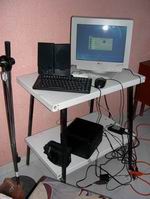 |
the electronic tools used to facilitate the production
of audio content were portable digital audio-recorders
and the vox pop boxes. The portable recorders were intended
mainly for field recordings, such as to interview, to cover
events, to record local news,... The vox pop boxes
were used to edit the recordings and transform them into
an interesting, self-contained transmittable audio piece.
|
| |
|
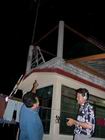 |
radio production
was based on guidance about what radio production is, group
work on individual ideas, and intuitive knowledge and hands-on
learning in the process. |
| |
|
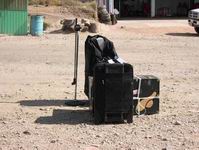 |
the sessions and the timing
of the workshop had to be adapted to the current activities
taking place in the town. From the first Sunday to Wednesday
there were many activities going on, religious, educational
and commercial. So field recordings were supposed to be
done on those days. From Thursday to Saturday editing took
place, and the transmission was on Sunday.
Taking into account the original
timing plan and the Tulcingo experience, it is important
to keep to the plan of allotting more days for editing than
for recording. Nevertheless, the festivities were valuable
input for the project, as Jesus and Don Carmelo had foreseen.
|
| |
|
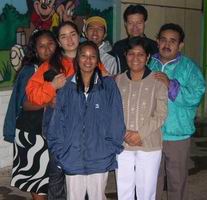 |
there were five group sessions distributed throughout
the nine-day workshop.
- the first session (Saturday 20, 9pm) was for introducing
the project, setting up group sessions and individual
work, presenting the tools and what the next step would
be, for the participants to start working on it.
- the second session (Wednesday 24, 9pm) was to see the
participants' progress with the field recordings and to
discuss their ideal final product. Then individual sessions
were also set up. The necessity of listening to a piece
already edited was brought up.
- the third session (Saturday 27, 9pm) was to decide the
transmission logistics and timings.
|
| |
- the fourth session (Sunday 28, 11am) was the simultaneous
transmission of the pieces in the town and at Casa Puebla,
New York. A phone call was placed during the whole transmission,
keeping both groups in touch. Towards the end of the transmission,
the Tulcingo participants were so enthused with having
listened to their radio program that they cheered for
the people in New York.
- the last session (Sunday 28, 9pm) was to evaluate the
work done, to listen to comments and discuss possible
improvements, to talk about future approaches and plans
and to celebrate the closure of the workshop.
The group relationship was very friendly. All the participants
had done different activities together.
|
| |
|
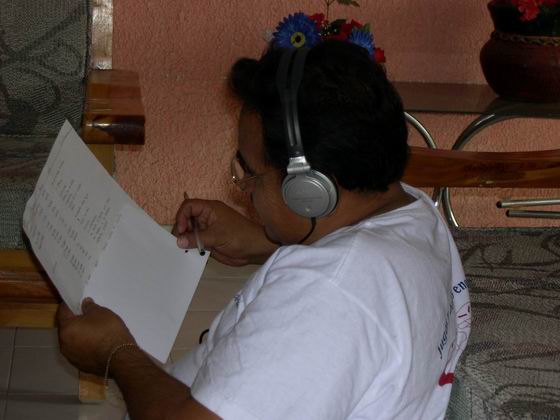 |
the extension and frecuency of the
individual sessions depended on the amount of editing
that was needed. Listening to the field recordings and choosing
the parts that were going to be used was the most time-consuming
part.
The edition process was different
for each piece, the same is true of the total time allotted
to each final product (audio piece). With one piece, total
editing time was about 14 hours. The other two were about
6 and 4 hours.
Each piece had a unique style of
how things were going to be said, what the message to be
conveyed was, and how the chosen parts of the recordings
were going to be put together.
on Monday 29, each of the participants
answered some questions about the workshop and tools; they
were visited at their homes/work places.
|
| |
|
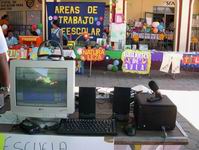 |
the project took place basically in two main locations:
- the operations center where group and individual sessions
were carried out was at David's place, downtown Tulcingo.
- the Internet connection for the project was at Armando's
Internet Café.
the eRadio Project had its own stand at the Tulcingo 2004
Educational Fair on Tuesday 23 April.
|
| |
|
| |
every night a backup of the
recordings and projects was done.
given the dialup connection, the uploading of audio files
to the server in Boston had to be done overnight on the
Saturday to Sunday night. Carla was on the Tulcingo side,
uploading, and on the USA side, Steve until early in the
morning. With Carla, was Israel, to make her company and
to make sure that mosquitoes were biting her just enough
to keep her awake.
the last Monday, a copy of the transmitted program
and the collection of pictures taken were burned onto a
CD for the town people.
|
| |
|
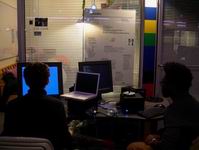 |
before the workshop, in Boston, Steve, Kow and Carla worked
hard on getting the system to run reliably and to have everything
ready for the workshop.
once the workshop in Tulcingo was running, Steve, on the
other side of the phone in Boston, was the technical support
behind the scenes.
for the New York transmission, Steve, Jesus and Don Carmelo
made sure that the place, the audio settings, the people,
and some food were ready for the transmission.
|
| |
|
|
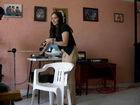
|
Carla was running the workshop in Tulcingo, coming up with
alternative plans for every challenge that sprung up.
|
|

